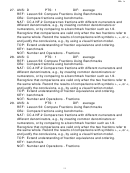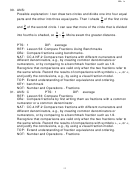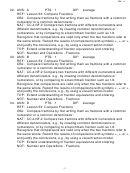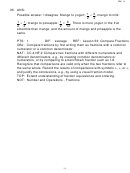Math Practice Test Page 17
ADVERTISEMENT
ID: A
4. ANS: B
PTS: 1
DIF: average
REF: Lesson 47: Investigate • Equivalent Fractions
OBJ: Use models to show equivalent fractions.
NAT: CC.4.NF.1 Explain why a fraction a/b is equivalent to a fraction (n x
a)/(n x b) by using visual fraction models, with attention to how the number
and size of the parts differ even though the two fractions themselves are
the same size. Use the principle to recognize and generate equivalent
fractions.
TOP: Extend understanding of fraction equivalence and ordering.
KEY: fractions | equivalent fractions
NOT: Number and Operations - Fractions
5. ANS:
I agree. Possible explanation: an equivalent fraction for 8
is 4
and an
10
5
equivalent fraction for 12
is 4
. So, they both walked the same distance.
15
5
PTS: 1
DIF: average
REF: Lesson 47: Investigate • Equivalent Fractions
OBJ: Use models to show equivalent fractions.
NAT: CC.4.NF.1 Explain why a fraction a/b is equivalent to a fraction (n x
a)/(n x b) by using visual fraction models, with attention to how the number
and size of the parts differ even though the two fractions themselves are
the same size. Use the principle to recognize and generate equivalent
fractions.
TOP: Extend understanding of fraction equivalence and ordering.
KEY: fractions | equivalent fractions
NOT: Number and Operations - Fractions
6. ANS: C
PTS: 1
DIF: average
REF: Lesson 48: Generate Equivalent Fractions
OBJ: Use multiplication to generate equivalent fractions.
NAT: CC.4.NF.1 Explain why a fraction a/b is equivalent to a fraction (n x
a)/(n x b) by using visual fraction models, with attention to how the number
and size of the parts differ even though the two fractions themselves are
the same size. Use the principle to recognize and generate equivalent
fractions.
TOP: Extend understanding of fraction equivalence and ordering.
NOT: Number and Operations - Fractions
2
ADVERTISEMENT
0 votes
Related Articles
Related forms
Related Categories
Parent category: Education
 1
1 2
2 3
3 4
4 5
5 6
6 7
7 8
8 9
9 10
10 11
11 12
12 13
13 14
14 15
15 16
16 17
17 18
18 19
19 20
20 21
21 22
22 23
23 24
24 25
25 26
26 27
27 28
28 29
29








